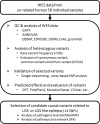Characteristics of Genetic Variations Associated With Lennox-Gastaut Syndrome in Korean Families
- PMID: 33584793
- PMCID: PMC7874053
- DOI: 10.3389/fgene.2020.590924
Characteristics of Genetic Variations Associated With Lennox-Gastaut Syndrome in Korean Families
Erratum in
-
Corrigendum: Characteristics of Genetic Variations Associated With Lennox-Gastaut Syndrome in Korean Families.Front Genet. 2021 Mar 5;12:669107. doi: 10.3389/fgene.2021.669107. eCollection 2021. Front Genet. 2021. PMID: 33747056 Free PMC article.
Abstract
Lennox-Gastaut syndrome (LGS) is a severe type of childhood-onset epilepsy characterized by multiple types of seizures, specific discharges on electroencephalography, and intellectual disability. Most patients with LGS do not respond well to drug treatment and show poor long-term prognosis. Approximately 30% of patients without brain abnormalities have unidentifiable causes. Therefore, accurate diagnosis and treatment of LGS remain challenging. To identify causative mutations of LGS, we analyzed the whole-exome sequencing data of 17 unrelated Korean families, including patients with LGS and LGS-like epilepsy without brain abnormalities, using the Genome Analysis Toolkit. We identified 14 mutations in 14 genes as causes of LGS or LGS-like epilepsy. 64 percent of the identified genes were reported as LGS or epilepsy-related genes. Many of these variations were novel and considered as pathogenic or likely pathogenic. Network analysis was performed to classify the identified genes into two network clusters: neuronal signal transmission or neuronal development. Additionally, knockdown of two candidate genes with insufficient evidence of neuronal functions, SLC25A39 and TBC1D8, decreased neurite outgrowth and the expression level of MAP2, a neuronal marker. These results expand the spectrum of genetic variations and may aid the diagnosis and management of individuals with LGS.
Keywords: Lennox-Gastaut syndrome; Rare-diseases; epilepsy; genetic variation; whole-exome sequencing.
Copyright © 2021 Yang, Choi, Yoon, Lee, Nam, Jun, Kwon, Yun, Jeon, Byeon, Halder, Kong, Lee, Lee, Kang and Kim.
Conflict of interest statement
The authors declare that the research was conducted in the absence of any commercial or financial relationships that could be construed as a potential conflict of interest.
Figures





Similar articles
-
A Novel X-Linked Variant of IQSEC2 is Associated with Lennox-Gastaut Syndrome and Mild Intellectual Disability in Three Generations of a Korean Family.Genet Test Mol Biomarkers. 2020 Jan;24(1):54-58. doi: 10.1089/gtmb.2019.0177. Epub 2019 Dec 12. Genet Test Mol Biomarkers. 2020. PMID: 31829726
-
Asymmetric Slow-Spike-Wave Patterns with Maximal Discharges Contralateral to MRI Lesions Predict Better Surgical Prognosis in Symptomatic Lennox-Gastaut Syndrome or Lennox-Gastaut Phenotypes.Pediatr Neurosurg. 2020;55(1):26-35. doi: 10.1159/000504513. Epub 2019 Dec 18. Pediatr Neurosurg. 2020. PMID: 31851997
-
Real-world use of the updated refractory epilepsy screening tool for Lennox-Gastaut syndrome.Epilepsia Open. 2024 Aug;9(4):1277-1286. doi: 10.1002/epi4.12952. Epub 2024 May 10. Epilepsia Open. 2024. PMID: 38726917 Free PMC article.
-
Conceptualizing lennox-gastaut syndrome as a secondary network epilepsy.Front Neurol. 2014 Oct 30;5:225. doi: 10.3389/fneur.2014.00225. eCollection 2014. Front Neurol. 2014. PMID: 25400619 Free PMC article. Review.
-
Lennox-Gastaut syndrome: a comprehensive review.Neurol Sci. 2018 Mar;39(3):403-414. doi: 10.1007/s10072-017-3188-y. Epub 2017 Nov 9. Neurol Sci. 2018. PMID: 29124439 Review.
Cited by
-
The different clinical facets of SYN1-related neurodevelopmental disorders.Front Cell Dev Biol. 2022 Dec 8;10:1019715. doi: 10.3389/fcell.2022.1019715. eCollection 2022. Front Cell Dev Biol. 2022. PMID: 36568968 Free PMC article.
-
Clinical trials for Lennox-Gastaut syndrome: Challenges and priorities.Ann Clin Transl Neurol. 2024 Nov;11(11):2818-2835. doi: 10.1002/acn3.52211. Epub 2024 Oct 23. Ann Clin Transl Neurol. 2024. PMID: 39440617 Free PMC article. Review.
-
Electro-Clinical Features and Functional Connectivity Analysis in SYN1-Related Epilepsy.Ann Neurol. 2024 Aug 23;97(1):34-50. doi: 10.1002/ana.27063. Online ahead of print. Ann Neurol. 2024. PMID: 39177219 Free PMC article.
-
How do plants remember drought?Planta. 2022 Jun 10;256(1):7. doi: 10.1007/s00425-022-03924-0. Planta. 2022. PMID: 35687165 Review.
-
Precision Therapeutics in Lennox-Gastaut Syndrome: Targeting Molecular Pathophysiology in a Developmental and Epileptic Encephalopathy.Children (Basel). 2025 Apr 8;12(4):481. doi: 10.3390/children12040481. Children (Basel). 2025. PMID: 40310132 Free PMC article. Review.
References
LinkOut - more resources
Full Text Sources
Other Literature Sources

